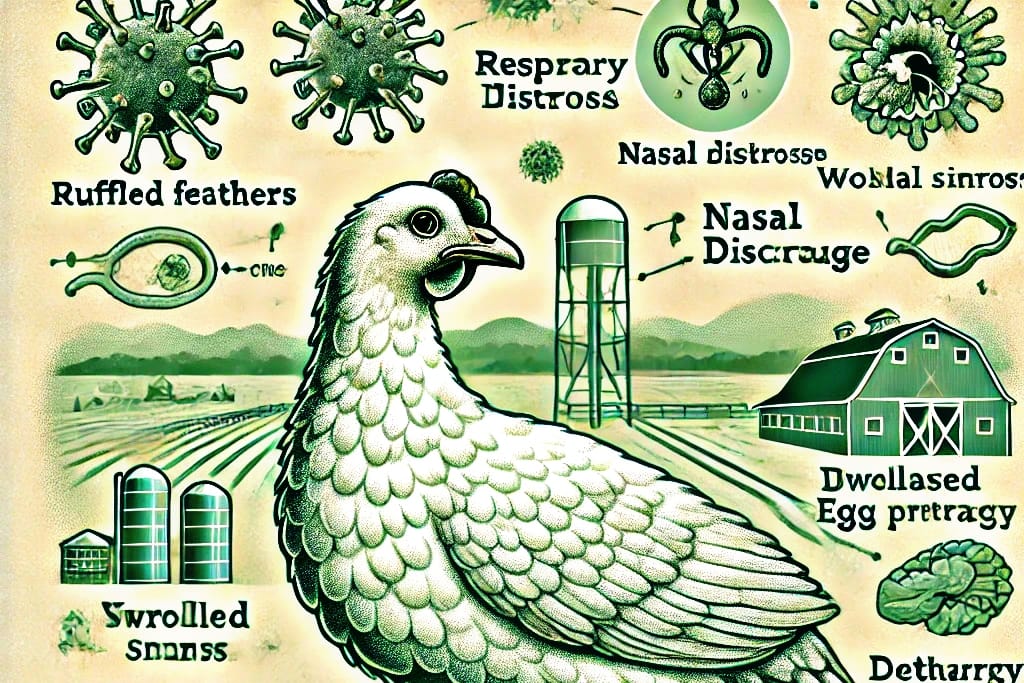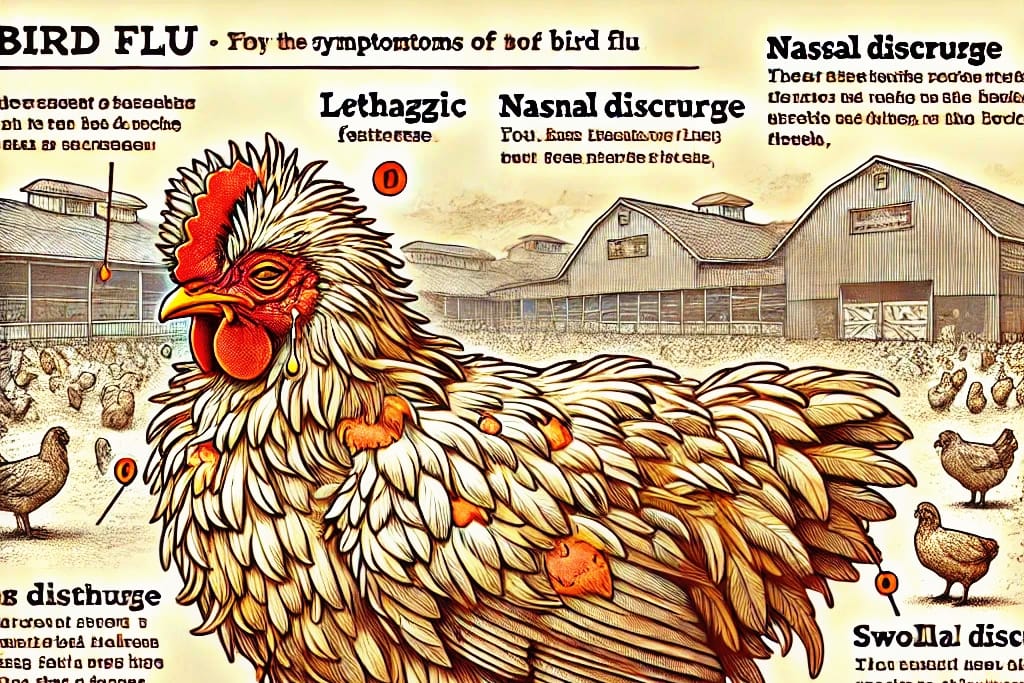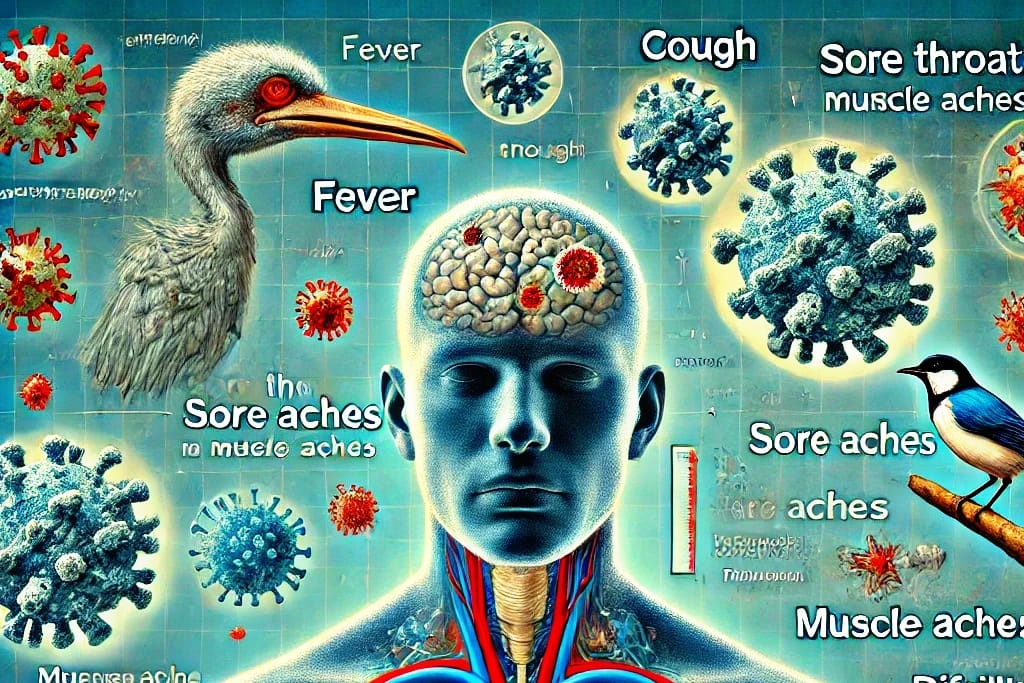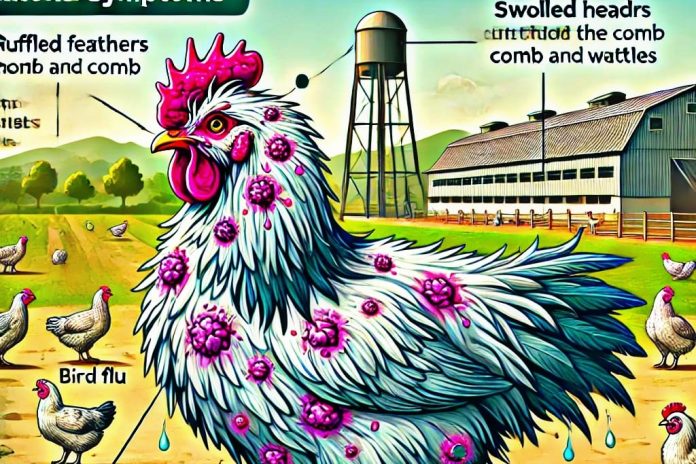Bird flu, scientifically known as avian influenza, is a viral infection primarily affecting birds, especially wild waterfowl and domesticated poultry. Caused by the avian influenza virus, bird flu can be highly contagious among bird populations, leading to widespread outbreaks in both commercial and backyard poultry farms. While bird flu typically does not cause significant harm in wild birds, certain strains can be fatal to domestic poultry, resulting in substantial economic losses and public health concerns.
In this article, we will focus on the symptoms of bird flu in birds, how to identify them, the potential risks posed by the virus, and the steps poultry farmers and bird owners can take to protect their flocks. By the end of this guide, you will have a comprehensive understanding of bird flu symptoms in birds, how to manage outbreaks, and prevent further spread.
What is Bird Flu?

Bird flu refers to a group of avian influenza viruses that infect birds, primarily affecting domestic poultry such as chickens, turkeys, ducks, and geese. The virus can also affect wild birds, particularly waterfowl like ducks and swans, which act as natural reservoirs for many strains of avian influenza. Although the virus primarily targets birds, it can, in rare cases, spread to humans and other animals.
The avian influenza virus is classified into two main categories based on the severity of the illness it causes in birds:
- Low Pathogenic Avian Influenza (LPAI): This type of bird flu typically causes mild illness or no symptoms in infected birds. LPAI is relatively common and may not result in significant losses in poultry.
- Highly Pathogenic Avian Influenza (HPAI): This type of bird flu causes severe illness and can result in sudden death in infected birds. HPAI is far more dangerous and can spread rapidly within a flock, causing large-scale mortality. The H5N1 and H7N9 strains are examples of highly pathogenic avian influenza viruses.
While the symptoms of bird flu in birds may vary depending on the strain of the virus, HPAI strains are generally much more severe and deadly. These strains are particularly concerning due to their ability to spread quickly and cause significant economic and health impacts.
How Does Bird Flu Spread?
The primary mode of transmission for avian influenza is through direct or indirect contact with infected birds or contaminated environments. The virus is shed through bird saliva, nasal secretions, and feces, which can contaminate food, water, bedding, and other surfaces in poultry farms. Wild birds, especially migratory waterfowl, are natural reservoirs of the virus and can spread it to domestic birds.
symptoms of bird flu in birds can spread in the following ways:
- Direct Contact: Infected birds can transmit the virus through close contact with healthy birds, especially in confined spaces like commercial poultry farms.
- Fecal Contamination: Bird flu can also spread through contaminated droppings that may come into contact with birds’ feathers, food, water, or equipment.
- Aerosol Transmission: The virus can be transmitted via airborne particles, particularly in crowded environments like poultry markets or farms.
While human-to-bird transmission of the avian influenza virus is rare, the risk of bird flu in humans increases in areas where there is extensive contact between humans and infected birds, particularly in live bird markets or during outbreaks.
Symptoms of Bird Flu in Birds

The symptoms of bird flu in birds can vary depending on the strain of the virus and the species of bird affected. The HPAI strains, such as H5N1 and H7N9, tend to cause more severe symptoms, leading to high mortality rates in infected flocks. On the other hand, LPAI strains may cause mild or no symptoms, making detection more challenging.
Here are the most common symptoms of bird flu in birds:
1. Sudden Death
One of the most alarming symptoms of highly pathogenic avian influenza (HPAI) is sudden death in birds. Infected birds may die within hours or days of showing symptoms. This rapid progression is characteristic of highly pathogenic strains like H5N1 and H7N9. Sudden death is often the first noticeable sign of bird flu in an infected flock, especially when there are no prior visible symptoms.
2. Severe Respiratory Distress
Infected birds may display signs of severe respiratory distress. This includes:
- Labored breathing: Birds may struggle to breathe and may exhibit signs of dyspnea (difficulty breathing), characterized by open-mouthed breathing or excessive panting.
- Coughing and Sneezing: Birds may cough or sneeze as the virus affects their respiratory system. You may notice mucus or nasal discharge around their nostrils.
- Swollen Head and Neck: The neck and face of infected birds may appear swollen due to fluid accumulation and inflammation.
These respiratory symptoms can be severe and can cause the birds to become lethargic and less active, making them more vulnerable to other infections.
3. Digestive Issues
Many birds infected with the avian influenza virus may develop gastrointestinal symptoms such as:
- Diarrhea: One of the more common symptoms of bird flu in birds is watery diarrhea, often accompanied by other signs of illness.
- Drop in Egg Production: In laying hens, bird flu can cause a significant drop in egg production. Infected hens may lay eggs with soft, misshapen shells or stop laying altogether.
These digestive issues can contribute to the overall weakness of the birds and increase the risk of secondary infections, which can worsen the illness.
4. Neurological Symptoms
symptoms of bird flu in birds may exhibit neurological signs such as:
- Head tilting: Birds may hold their heads in an abnormal position or appear disoriented.
- Loss of balance: Infected birds may have difficulty standing or walking and may appear uncoordinated or staggering.
- Tremors or Twisting: Some birds may experience tremors or twisting of the neck and body due to the virus’s impact on the nervous system.
Neurological symptoms are more common in highly pathogenic strains of avian influenza and can significantly affect the behavior and coordination of infected birds.
5. Swelling and Hemorrhaging
Swelling in various parts of the body, including the head, neck, and legs, is a common symptom of bird flu, especially in HPAI infections. Swollen areas are often the result of fluid accumulation due to inflammation and infection.
Hemorrhaging (bleeding) can also occur, particularly in the legs, wings, and around the eyes. The birds may have noticeable bruising or blood spots under the skin, which can be seen around the beak, eyes, or vent.
6. Change in Appearance
Birds infected with the avian influenza virus may have a noticeable change in their overall appearance:
- Pale combs and wattles: The comb and wattles (the fleshy parts on the head and neck) of infected birds may appear pale or blue-tinged due to lack of oxygen in the blood.
- Wet, matted feathers: Birds may have damp or matted feathers due to the discharge from the eyes, nose, or mouth.
- Lethargy and Weakness: Infected birds may appear very weak, spend a lot of time sitting or lying down, and may be less active than usual.
7. Drop in Feed and Water Consumption
Infected birds may show a reduced appetite or lack of interest in food and water, contributing to dehydration and overall weakness. This can exacerbate the negative effects of the virus on the bird’s health and lead to faster deterioration.
8. Eggshell Abnormalities
Infected laying hens may exhibit changes in egg quality, including:
- Soft-shelled eggs: Birds with bird flu may lay eggs with soft or fragile shells, making them more prone to breakage.
- Misshapen eggs: The shape of the eggs may be irregular or deformed.
- Drop in egg production: A significant decline in egg production is a common indicator of bird flu in hens and other egg-laying birds.
How to Confirm symptoms of bird flu in birds

If you suspect that your flock has been infected with avian influenza, it is essential to consult a veterinarian and take immediate steps to confirm the diagnosis. Diagnosis is typically made through laboratory tests, including:
- PCR testing: Polymerase chain reaction (PCR) testing is used to detect the genetic material of the virus in samples taken from the bird’s respiratory or gastrointestinal tracts.
- Virus isolation: Samples from sick birds can be sent to a laboratory where they are cultured to confirm the presence of the avian influenza virus.
- Serological tests: These tests detect antibodies produced by the bird’s immune system in response to the virus.
Prompt testing and diagnosis are crucial for controlling the spread of symptoms of bird flu in birds, particularly in commercial poultry operations.
Symptoms of Bird Flu in Birds – Preventing and Managing
There are several preventive measures and management strategies that can help reduce the risk of bird flu outbreaks:
- Biosecurity Practices: Maintain strict biosecurity measures on poultry farms to prevent contact with wild birds and contaminated equipment or environments.
- Quarantine New Birds: Isolate new birds from the existing flock for at least 30 days to monitor them for any signs of illness before introducing them to the main group.
- Vaccination: In some regions, poultry vaccines are available for certain strains of avian influenza, although these are not universally effective against all strains.
- Regular Monitoring: Regularly check for symptoms of bird flu in your flock and keep records of any changes in behavior, egg production, or overall health.
- Culling Infected Birds: In the event of an outbreak, immediately cull infected birds to prevent further spread of the virus. Ensure that proper disposal methods are followed to prevent contamination.
Conclusion – Symptoms of Bird Flu in Birds
The symptoms of bird flu in birds can range from mild respiratory issues to severe, fatal outcomes. Highly pathogenic avian influenza (HPAI) strains like H5N1 and H7N9 are particularly concerning, as they can cause rapid death and widespread infection in poultry. Early detection is critical for preventing the spread of the virus and minimizing economic losses in the poultry industry.
By recognizing the symptoms of bird flu in birds and taking the necessary steps to prevent outbreaks, poultry farmers and bird owners can protect their flocks and help limit the public health risks associated with this potentially devastating disease.
Proper biosecurity, regular monitoring, and prompt response are key to keeping bird flu under control and ensuring the health of your poultry.

